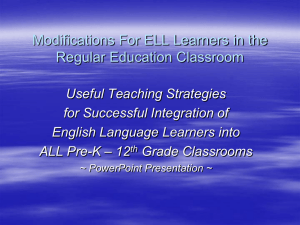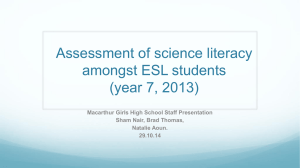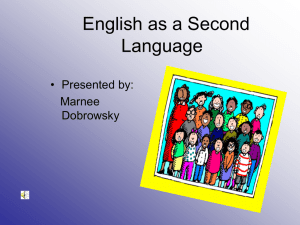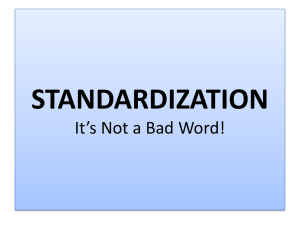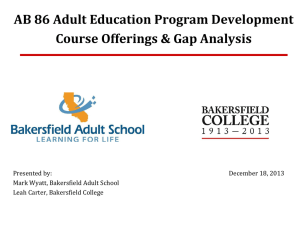Presentation by Andrea Fraundorfer, Head of the Unit for tackling
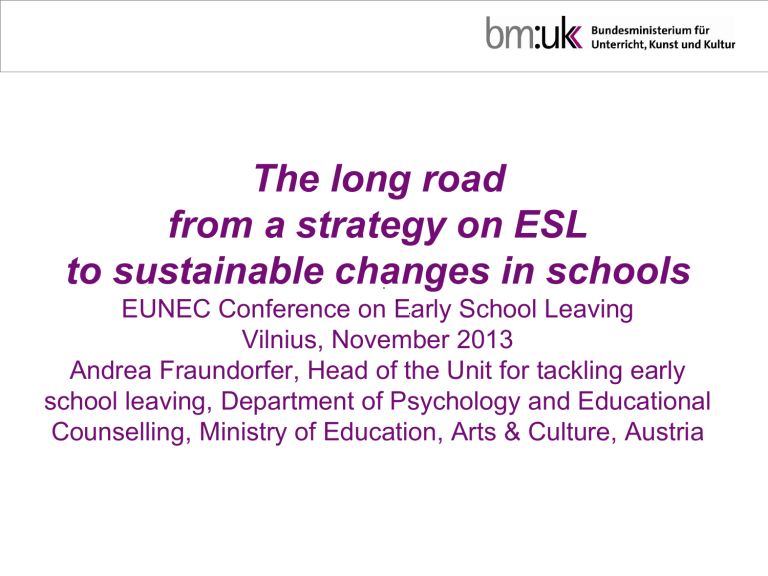
The long road from a strategy on ESL to sustainable changes in schools
EUNEC Conference on Early School Leaving
Vilnius, November 2013
Andrea Fraundorfer, Head of the Unit for tackling early school leaving, Department of Psychology and Educational
Counselling, Ministry of Education, Arts & Culture, Austria
Overview
Part I: Current situation in Austria
Terminology revisited: ESL – School Failure? Dropouts – Pushouts? NEET?
Data on ESL
Austrian strategy on ESL and “Youth Coaching“ as a targeted measure and
“Fit for Training“ as a subsequent measure
Part II: The long road to making schools a better place for students at risk
Structural / systemic / pedagogical challenges in the context of ESL
Gap between (research) findings and school practice
Whole-school approaches and quality initiatives in schools
Outlook
Terminology (revisited) and different perspectives
Early School Leaving refers to the completion of upper secondary school or vocational training with a certificate – the person and his/her certificates are monitored
School Failure corresponds to a broader and systemic perspective (OECD: “Equity and Quality in Education. Supporting
Disadvantaged Students and Schools”, 2012)
NEET : young people, n ot in e ducation, e mployment and t raining – this perspective combines labour market & educational monitoring
Dropouts – Pushouts?
Reflecting & overcoming the individual deficit perspective…
…for the benefit of a broader perspective
Definition of School Failure (OECD 2007/2012)
“From a systematic perspective , school failure occurs when an education system fails to provide fair and inclusive education services that lead to enriching student learning. At the school level , school failure can be defined as the incapacity of a school to provide fair and inclusive education and an adequate environment for students to achieve outcomes worthy of their effort and ability. From an individual perspective , school failure can be defined as the failure of a student to obtain a minimum level of knowledge and skills, which can at the extreme level lead to dropping out of school.”
(OECD: Equity and Quality in Education, 2012, p. 18)
Data on ESL in Austria
However… Certificates = Competences?
Discourse on
“Poverty in certificates and competences“
(dt.:
Zertifikats- und Kompetenzarmut = “Bildungsarmut”, Jutta Allmendinger /
Stephan Leibfried)
How do we tackle this gap? What are the underlying causes?
Youth Coaching – a targeted measure to deal with students at risk
•
Jointly-run project between the Ministry of Labour and Social Affairs
(BMASK) and the Ministry of Education , funded by BMASK; concept developed by the Federal Social Service (“Bundessozialamt”); different organizations provide Youth Coaching in schools and counselling centres
•
Pilot projects in Vienna and Styria (C’mon 14, move on); former measure
“Clearing” for students with special needs
•
Youth Coaching offers counselling on educational and vocational pathways for students at risk and helps them make self-determined career decisions; NEET as target group
•
Individual support and assistance is provided until integration into (initial vocational) training or the labour market is under way.
Follow-up measure
New measure for 2014: “Fit for training“
supports the most disadvantaged youth identified by youth coaches
targeted follow-up measure for youngsters who fail in apprenticeships and training, etc.
provided by Federal Social Service, funded by Ministry of Social
Affairs
one-year intensive customized training & empowerment
compensation for missing skills & poor competences
tailor-made “after-maturing“
(dt. „Nachreifung“)
focus on migrant youth with low SES and NEET
Challenges at system level
Drawing a bigger picture in education?
Selectivity of the system not reinforcing existing inequalities (SES – outcomes)?
Bringing different sectors into alignment?
Changing schools without extra resources?
Making schools accountable without control over budget & staff? Paradigm shift?
Education / formation competences/qualification/ employability?
Missing knowledge about interrelation SES & ESL in schools and concrete ways of breaking the cycle
Fragmented governance / responsibilities & funding, short-term periods of funding
Expansion of school autonomy ? Clear aims?
More responsibility for head teachers?
Implementing & monitoring quality initiatives
Identifying competence gaps and improving instruction
Implementing whole school approaches to ESL
Changing professional attitudes and patterns
Accountability of teachers and schools
Additional resources & staff
(index-based funding?)
Conducive / supportive learning environments
Challenges at school level
Tension between focus on outcomes and customized / personalized learning
Enough knowledge about the different pathways for effective learning & teaching?
Dealing with linguistic diversity and late migrant arrivers ?
Co-operation between different professionals
Topics: leadership, school
/culture, aims and outcomes, support, teacher training
The gap between (research) findings and practice …
Appropriate and early support is crucial.
Diagnostic competences of teachers are important .
Classroom atmosphere / school culture and school leadership matter.
Teachers’ attitudes / learning approaches are critical.
Support for teachers and students is crucial: social work, counselling teachers, support structures, … burn-out prevention for teachers
Positive discrimination for disadvantaged students + index-based funding for disadvantaged schools
Improvements in teaching & learning environments + a broad scope of different teaching and learning methods
What can be done to put these findings into classroom practice? How to train teachers in an effective way?
Whole-school approach & quality initiatives
(Good practice in VET)
School quality circle:
PLAN – DO – CHECK – ACT
Analysis of the current situation (number of ESL & causes)
Definition of objectives to tackle ESL + definition of indicators of success
Short-term and long-term measures (differentiated instruction, additional language support, remedial programmes, case management & counselling, parental involvement, tutoring and mentoring, transitional year , …)
Evaluation of success / failure
Rephrasing & redefining objectives and measures combined with early detection + targeted support
( www.stop-dropout.at
)
Outlook
We can‘t turn schools around within a short period of time .
But we can initiate and support change in school culture & professional attitudes to combat ESL and to break the cycle of disadvantage.
There are no recipes for bringing about change.
But we can make schools and teachers sensitive to the mechanism
of disadvantage and the interrelation between SES and ESL through quality initiatives and professional development.
ESL will continue at a certain level .
But we can reduce it to a minimum and keep the future (and educational systems) open for young people by means of joint and coordinated
efforts, tailor-made programmes and a strong commitment on the part of the people in charge.
What we need for sustainable change is …
• to overcome the individual deficit perspective in favour of a wider social inequalities perspective which avoids ‘blaming the victim ‘ and takes into account the individual living circumstances of young people
• a social justice approach & a new paradigm in education that confronts and counteracts disadvantage and the marginalization of young people and reflects discriminatory school practices at all levels
• to improve awareness & responsibility at all levels .
Contact and further information:
Dr. Andrea Fraundorfer
Federal Ministry of Education, Science and Arts (BMUKK)
Vienna, Austria andrea.fraundorfer@bmukk.gv.at




